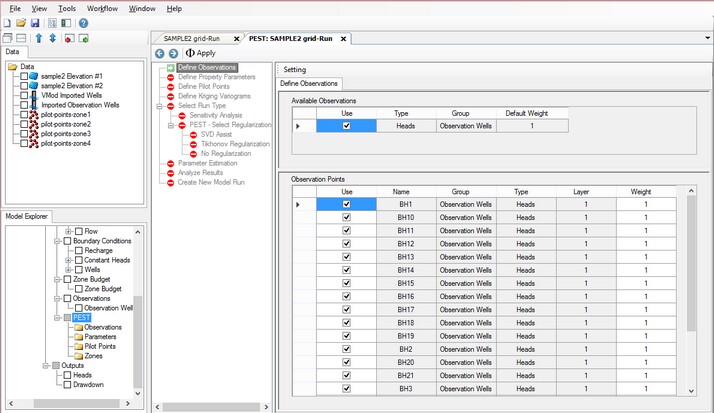When PEST is used to assist in the calibration of a model, it is asked to minimize an objective function, represented by the symbol Φ .This is comprised of the sum of the weighted squared deviations between the calculated and observed system responses. The difference between the calculated and observed values are referred to as a residual, and represented by the following equation:
ri = (Xcalc-Xobs)
The objective function, Φ, is calculated using the following equation:

In the case of a groundwater model, these system responses are typically head at a point in space, concentration at a point in space, or groundwater flow to a specified zone.
At the Define Observations step, you will see a list of all your available head observations as shown in the following figure:

The observation values are assigned a default weight of 1.0, which means the residual will not be modified.
We want PEST to:
| · | give more weight to measurements that you can trust |
| · | give greater priority to measurements in areas where predictions are important |
| · | decrease bias that is introduced by denser data (if appropriate) |
| · | give equal weight to observations with different units (eg. Heads vs. Fluxes, vs Concentrations) |
The weight factor is commonly used to normalize observations of different types. For example, when you have head and flux observations included in the same PEST run, the flux residuals are typically much higher than a head residual. For example:
| · | a flux residual for a set of cells could be +/- 1000 m3/day |
| · | a head residual at a single cell is +/- 1m. |
PEST calculates the objective function by summing the squares of these residuals, which results in flux observation residuals being several orders of magnitude greater than the head residuals. As a result, PEST will focus more on minimizing the flux residuals, and less so on the head residuals, which is most likely undesired from the modeler's view point.
The solution is a user-defined weighting factor (wi)

We use a weight less than 1.0 to reduce the magnitude of flux errors so they are comparable to head errors. A similar problem is often seen with concentration targets, for the same reason. The ability to use weights to address a variety of common calibration issues makes the objective more useful.
Settings
If you click on the [Setting] button above the Observations grid, you can adjust the Time Extrapolation Limit; this value is used by PEST to search for the nearest observation time for comparing to calculated MODFLOW output times. The higher the value, the more likelihood that an observation time can be found to match the MODFLOW output times. The default is 100 (in the project time units).